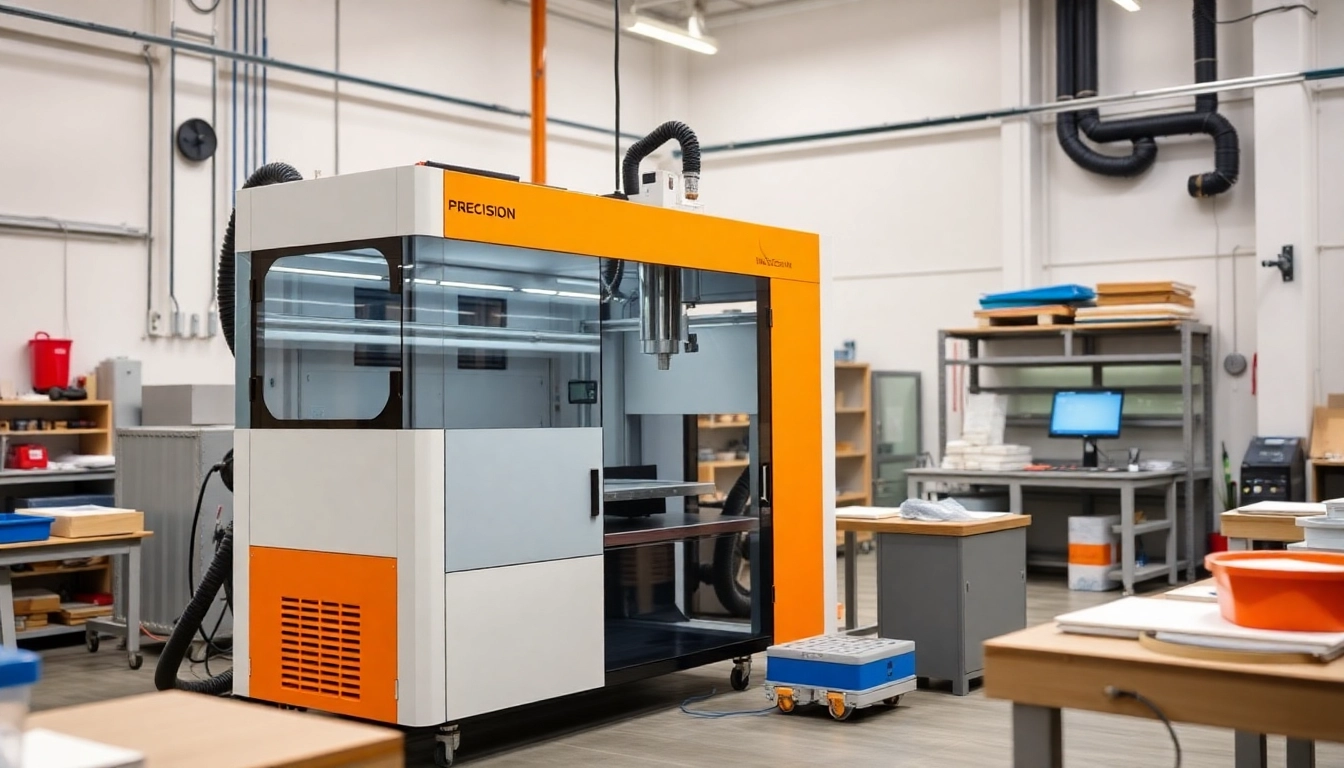What is Machine Vision?
Machine vision refers to the technology and methods that allow computers to interpret and understand visual information from the world around them. This capability empowers automated systems to conduct imaging-based inspections, facilitating various operational processes across numerous industries. At its core, machine vision combines hardware, such as cameras and sensors, with software to analyze visual data, ultimately enabling machines to perform tasks that traditionally required human intervention. For a more detailed exploration of these concepts, you can check out this machine vision resource.
Definition and Basic Principles
The fundamental principle of machine vision is the automated interpretation of visual information. It begins with the capture of images through various sensors, which might include standard cameras or more specialized systems capable of handling different wavelengths beyond the visible spectrum. These images are then analyzed using sophisticated algorithms that process the data to identify patterns, features, and anomalies.
Machine vision systems are often categorized based on their operational framework, including:
- 1D Machine Vision Systems: These systems analyze linear visual data, often used in applications like barcode reading.
- 2D Machine Vision Systems: The most common implementation, where two-dimensional images are processed to detect defects or guide assembly lines.
- 3D Machine Vision Systems: These systems utilize depth perception to understand spatial relationships in images, significantly enhancing inspection capabilities.
- Spectral Imaging: This technology captures images across various wavelengths, allowing for material identification based on their spectral signature.
How It Works: Key Components
Machine vision systems typically consist of the following key components:
- Cameras: The starting point for image capture. Cameras can be categorized based on resolution, sensitivity, and type (e.g., color, monochrome, infrared).
- Lighting: Essential for ensuring high-quality image capture, varying lighting conditions can greatly affect image clarity and quality.
- Processing Hardware: Includes computers and processors that handle the real-time data processing required for analysis.
- Software: Algorithms for image processing and analysis that identify patterns, detect defects, and make decisions based on the visual data.
- Output Devices: Interfaces that communicate results to human operators or control systems to enact necessary actions based on analysis.
Differences Between Machine Vision and Computer Vision
While often used interchangeably, machine vision and computer vision refer to different concepts:
- Machine Vision: Primarily focuses on specific tasks within industrial settings, automating processes such as inspection, quality control, and measurement.
- Computer Vision: Encompasses a broader range of capabilities, including image recognition, scene understanding, and various applications outside industrial settings, such as self-driving vehicles or facial recognition systems.
Applications of Machine Vision
Machine vision has a broad range of applications across various sectors, demonstrating its versatility and potential for enhancing operational efficiency.
Industrial Automation and Quality Control
In manufacturing, machine vision systems play a critical role in automating quality control processes. By employing high-definition cameras and sophisticated software, these systems can inspect thousands of components per minute, identifying defects and inconsistencies with precision that far surpasses human capabilities.
For example, in automotive assembly lines, machine vision can ensure that each component is correctly assembled by verifying the presence, orientation, and quality of parts before they proceed to the next stage. This not only speeds up the manufacturing process but significantly reduces the risk of human error.
Medical Imaging and Diagnostics
In the medical field, machine vision systems are increasingly used for diagnostic purposes. Advanced imaging technologies merge with machine vision to provide detailed analyses of medical images. For instance, systems are employed for analyzing X-rays, MRIs, and CT scans, where they can assist radiologists by identifying anomalies such as tumors or fractures.
Furthermore, in laboratories, machine vision is pivotal for automating tasks like cell counting or identifying specific cell types in samples, accelerating research and diagnostic timelines considerably.
Robotics and Autonomous Systems
Machine vision is fundamental to the development of autonomous systems, including robots and self-driving vehicles. In robotics, machine vision allows systems to navigate environments, interact with objects, and perform complex tasks that require a high level of dexterity and decision-making capabilities. For instance, service robots in hospitals use machine vision to identify and locate equipment or assist in patient care.
Self-driving vehicles rely heavily on machine vision to interpret their surroundings, enabling them to recognize road signs, detect pedestrians, and avoid obstacles, making roadway navigation safer and more efficient.
Benefits of Implementing Machine Vision
The integration of machine vision within operational frameworks provides measurable benefits that contribute to higher productivity and profitability.
Improved Accuracy and Efficiency
One of the most significant advantages of machine vision is its ability to enhance accuracy in tasks that require precision. By analyzing images more thoroughly than the human eye, machine vision systems can spot minute defects, ensuring high-quality output every time. This level of scrutiny and reliability leads to enhanced operational efficiency since fewer errors translate to reduced rework and higher overall productivity.
Cost Reduction Through Automation
Implementing machine vision often leads to substantial cost savings. By automating repetitive inspection and quality control tasks, organizations can reduce labor costs and minimize waste resulting from defects. Over time, the return on investment (ROI) becomes more apparent as operational costs decline while production rates increase.
Real-time Data Analysis and Decision Making
Machine vision systems provide instant feedback by analyzing images in real-time. This capability enables businesses to make immediate decisions based on current data, improving response times in production or customer service scenarios. Such agility can be a decisive competitive advantage in fast-paced industries.
Challenges in Machine Vision
Despite its numerous benefits, some challenges can impede the effective implementation of machine vision systems.
Technical Limitations and Solutions
Technical limitations such as image resolution and processing speed can affect system performance. For instance, cameras must be selected based on the specific requirements of the application, including the required resolution and the environment in which they operate (e.g., varying lighting conditions).
Solutions include continuous updates of hardware capabilities, utilizing machine learning to improve image processing algorithms, and investing in better lighting technology to enhance image capture quality.
Integration with Existing Systems
Integrating machine vision systems with existing machinery and operational workflows can pose challenges. Without careful planning, compatibility issues can lead to inefficiencies or malfunctions. Therefore, it’s crucial to conduct thorough assessments and potentially work with system integrators to ensure smooth integration and functionality alignment.
Cost of Implementation
The initial costs associated with implementing a machine vision system can be daunting for some companies. However, organizations must evaluate these costs against the long-term savings and productivity enhancements that machine vision can provide. Developing a clear ROI analysis can help stakeholders make informed decisions regarding investments in machine vision technology.
Future Trends in Machine Vision
The future of machine vision is promising, with ongoing developments expected to reshape the landscape of automation further.
A.I. and Machine Learning Integration
The integration of artificial intelligence (A.I.) and machine learning into machine vision systems is a significant trend. A.I.-powered algorithms can learn from vast datasets, improving their accuracy over time. By enhancing image processing, these technologies can better identify complex patterns, enabling more refined product inspections and quality assurance protocols.
Emerging Technologies and Innovations
Advancements in imaging technologies, such as high-speed cameras and multispectral cameras, are paving the way for new applications. Innovations in 3D imaging and augmented reality are also progressing, allowing operators to overlay critical information during inspections or maintenance tasks, enhancing real-time decision-making capabilities.
Market Outlook and Growth Opportunities
The machine vision market is expected to grow significantly, propelled by increasing demands for automation across different industries. As technology becomes more affordable and accessible, small- and medium-sized enterprises are expected to adopt machine vision systems, leading to greater market penetration and diversity of applications. The future is set to see an expansion in machine vision’s presence across medical, manufacturing, and logistics sectors.



